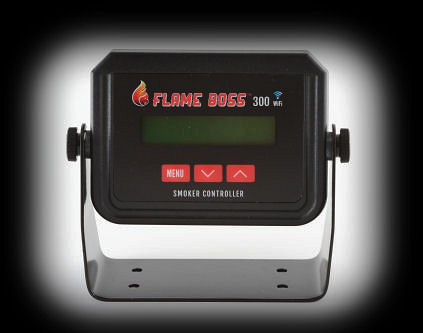 |
 |

The barbecue temperature controller market was pioneered and has long been dominated by The BBQ Guru's line of controllers. However, several other players have entered the market in the past several years including The Stoker, Auber Instruments, and pitmaster.com. In September, 2013, Flame Boss entered the market with the original Flame Boss 1. That was followed by the Flame Boss 100, and then by the Flame Boss 200 which added the easiest to use Wifi implementation on the market. So now in 2017, Flame Boss introduces the 300 which allows you to add two extra meat probes via some y-cables and a new Pit Temperature Alarm feature. We'll also take a look at their recently introduced high temperature probes which are now an option. Here are the specifications listed on the Flame Boss web site for the 300 Wifi controller:
Plus we'll add a few notes of our own:
Compared To Other BBQ Temperature Controllers The Flame Boss 300 Wifi controller compares to the BBQ Guru CyberQ Wifi unit, both having a food probe, controlling one cooker, and having Wifi capability. The newly announced BBQ Guru CyberQ Cloud appears to be a an even closer match to the abilities provided by the Flame Boss 300, with 3 food probes and cloud capability. Of course the Stoker Wifi has Wifi, but it really is a step above these controllers in that it can control as many cookers simultaneously as you care to hook up. Here's what comes with a basic system:
A Few Observations About The Components The control unit is in a plastic case which is not necessarily watertight, but should be able to resist some moisture. It also comes with a metal bracket to hold it that is made from sturdy powder coated metal. The original temperature probe cables are made from braided stainless steel and covered with PTFE. The new high temperature probes omit the PTFE coating. In general, everything seems to be rugged enough to do the job. One additional note about the metal bracket that comes with the Flame Boss 300. It now has an additional notch where it holds the two side screws of the controller that prevents the screws from slipping out of the slot when you tighten them. A nice improvement over the bracket that came with the Flame Boss 200.
The system unit is a small plastic box about 4¼" x 1⅛" x 3⅛". It comes with a metal bracket for mounting. The case is not waterproof, but should be able to withstand a small amount of moisture. The case houses the electronics and has the display and control buttons on the front. There is no power switch. The unit turns on when connected to power and off when disconnected from power. Except for the labeling, the Flame Boss 300 system unit is very similar in appearance to previous models.
Let's look at the front panel details. In the photo below, you can see the display and control buttons:
First, the display. As you can see, it shows the target pit temperature (SET), the actual pit temperature, the blower's percentage of capacity it is blowing, and the meat temperature. When you attach multiple food probes, the MEAT field will scroll between the various probe values. When you cycle through the various menu options, they will be displayed on this display instead of what you see in the photo. One other note about the display. There is a setting in the menu called "LCD Contrast" which allows to adjust the appearance of the display. Frankly, the default setting of 50 is probably the best setting, so you may not ever need to adjust this. On to the control buttons. As you can see there are only 3 buttons. The menu button enters the menu and scrolls through the menu items. After you go through the all the menu items, the display returns to what you see in the photo above. The up and down buttons will alter the target pit temperature if the unit is displaying what you see in the photo above. Note that if you do alter the pit set temperature, an asterisk will appear next to it. After a short while, the asterisk disappears. The asterisk indicates that the new pit temperature has not been stored in non-volatile memory yet. When the asterisk disappears, then you know that the pit set temperature has been safely stored. If you are running through the menu items, the up and down buttons alter the value of the current menu item and pressing the menu button accepts the current value. Also, when you press any of the buttons there is a satisfying "bump" to let you know that the press has registered. |
You can support this website by shopping at The Naked Whiz Website Store and Amazon.com
|